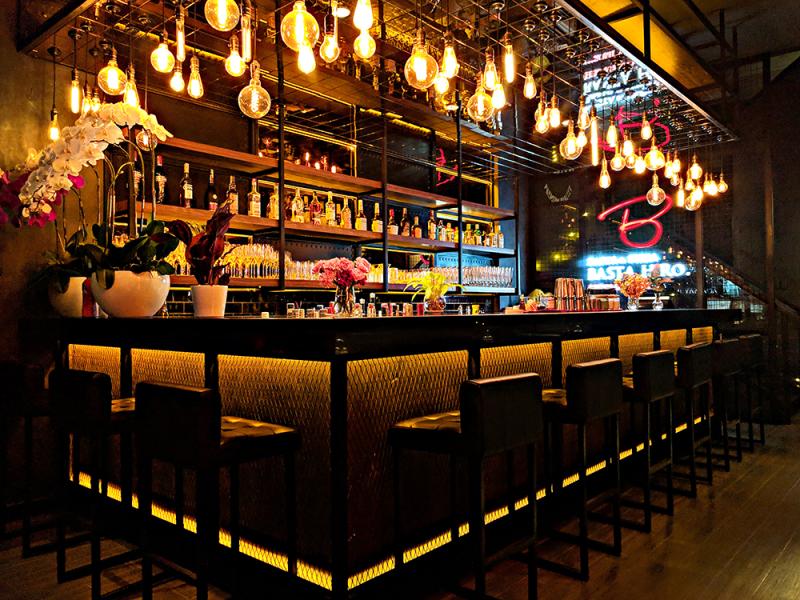Welcome to our series on bar design!
Over the next few weeks, this three-part article series will look closely at bar design trends, best practices and biggest mistakes in bar design, and why bar design is so closely related to profit.
In this first installment, we’ll be talking about the “why” of bar design. Isn’t any bar with guest seating, a speed rail, and a competent bartender manning the shaker enough to make money? As it turns out, no. And considering the average bar profit margin is about 70-80% compared to below 15% for food, it’s a part of your establishment that you want to make sure you get right.
Bar and beverage equipment manufacturer Perlick recently held a bar design class titled “Bar Design 101” at E3 Commercial Kitchen Solutions. Led by Corporate Training Manager & Perlick Brand Ambassador Corrinne Walenda, the session covered some of the reasons why liquor is so profitable:
- Labor costs behind the bar are much lower than in the kitchen.
- Alcohol can have large markups for prices—upwards of four times the wholesale cost.
- Alcohol has a longer shelf life, which limits waste.
- Alcohol provides many opportunities for upselling.
- Guests typically order more than one round of drinks.
While a 70-80% profit with an average cocktail pour cost between 20-30% is good, by decreasing the poor cost to 12-15%, bars can increase that profit margin to an even better 85-88%. Here are some ways to accomplish that.
Pour Cost
First, it’s good to know how to calculate your overall pour cost. Use this equation:
Inventory Usage ÷ Sales = Pour Cost
Aside from an understanding of your general pour cost, it may also be helpful to run reports on your POS to calculate the pour cost for each drink on your bar menu. You can then compare it to that drink’s sales volume to get an idea of how the offerings on your menu stack up.
Drinks with high pour costs but little sales volume? Time to get rid of them.
Consider adding some of the most profitable cocktails to your menu, if you don’t have them on there already. According to Perlick’s Walenda, a Moscow Mule is the most profitable drink, which is made from vodka, ginger beer, and lime juice, and it’s a good addition to your cocktail menu. Other profitable cocktails according to The Cocktail Profitability Handbook from Bevspot Trends are the Tom Collins, Daiquiri, and the Paloma.
Product Mix
Aside from high-profit drinks, other ways to maximize your liquor profitability, according to Perlick’s Bar Design 101 class, are:
- Pre-batch cocktails: Pre-batching is especially good for the current labor-strapped environment where the industry has had an influx of many inexperienced bartenders. These types of cocktails are also faster to serve and reduce waste. Walenda points out that a bar program should be designed according to the least experienced bartender, and pre-batch cocktails are a great way to meet that need.
- Wine by the glass: There is plenty of profit to be made per pour when serving wine by the glass versus the bottle.
- Premium liquors: Premiumization still reigns, and consumers used to trading up to premium options in the off-premise will be looking for the same from the on-premise.
- Craft ice: Clear ice, branded ice, and large cubes or spheres can help to not only elevate the cocktail, but its price as well.

The Bar
On the surface, the above points may not seem to have anything to do with the actual design of the bar, but they are related. A well-designed, efficient bar will set you up for success in getting the drinks mentioned above out quickly and correctly while increasing your profit margin. A good bar set up can help raise the number of drinks you sell and increase the total share that liquor contributes to your overall bottom line. And with that share coming in at over 80% profit margin, there is big money to be made.
The major takeaway? Design your bar first for financial success. All of the elements that contribute to profitability mentioned above won’t work if your bar is designed poorly, you don’t have enough cocktail stations, or you’re lacking the right equipment.
Look for the second installment of our bar design series next week where we'll be discussing the best practices and biggest mistakes of bar design.
Plan to Attend or Participate in Bar & Restaurant Expo, March 27-29, 2023
To learn more about the latest trends, issues and hot topics, and to experience and taste the best products within the bar, restaurant and hospitality industry, plan to attend Bar & Restaurant Expo, March 27-29, 2023 in Las Vegas. Visit BarandRestaurantExpo.com.
To book your sponsorship or exhibit space at Bar & Restaurant Expo, contact:
Veronica Gonnello (for companies A to G) e: [email protected] p: 212-895-8244
Tim Schultz (for companies H to Q) e: [email protected]p: (917) 258-8589
Fadi Alsayegh (for companies R to Z) e: [email protected]p: 917-258-5174
Also, be sure to follow Bar & Restaurant on Facebook and Instagram for all the latest industry news and trends.
